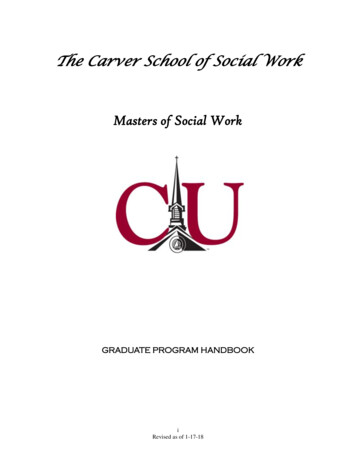
Transcription
Social Work & the AffordableCare Act: Maximizing theProfession’s Role in Health Reform
ACKNOWLEDGEMENTSThis publication is sponsored by the Brown School at Washington University, the Center forHealth Administration Studies at the University of Chicago, and the College of Social Work at theUniversity of South Carolina.Lead Authors/Event Co-ChairpersonsChristina Andrews and Teri Browne (University of South Carolina)Contributing Authors and National Advisory CommitteeHeidi Allen (Columbia University)Darla Spence Coffey (Council on Social Work Education)Stacy Collins (National Association of Social Workers)Sarah Gehlert (Washington University)Robyn Golden (Rush University Medical Center)Jeanne Marsh (University of Chicago)Timothy D. McBride (Washington University)Angelo McClain (National Association of Social Workers)Edward Woomer (Society for Social Work Leadership in Health Care)The planning committee would like to thank the following individuals for their assistance andexpertise:ModeratorsHeidi Allen, Robyn Golden, Timothy McBride, Marjorie Sable, Anna ScheyettSpeakersJeff Capobianco, Julie Darnell, Robyn Golden, Barbara Jones, Sarah Gehlert, Linda ShapiroScribes and Research AssistantsSara Goldsby, Corinne Mercogliano, Randy MooreAdministrative AssistantDorothy Kennedy
Event CoordinatorCarmella SnookFacilitatorMarj PlumbSponsors
EXECUTIVESUMMARYThe Affordable Care Act (ACA) is generatingsweeping changes in the financing, organization,and accessibility of health and social services in theUnited States. The expansion of Medicaid and theestablishment of state health insurance exchangeshave vastly expanded insurance access in the UnitedStates, with an estimated 15 million Americans gainingcoverage (Kaiser Commission on Medicaid and theUninsured, 2014; United States Department of Healthand Human Services, 2014). Emphasis on integratedmodels of care and payment reform, including healthhomes and accountable care organizations, introducesnew opportunities to improve care coordination,reduce unnecessary service use, and make care morecost-effective. An increased focus on health promotionseeks to redefine the aims of health care towardspromoting wellbeing rather than treating illness.Realization of these changes will rely on the work ofmany health care professions, including social work.In light of these changes, a strategic planning meetingwas convened to develop recommendations for howsocial work can maximize its contributions to the ACA.The meeting was organized by a National AdvisoryCommittee with leaders from the Society for SocialWork Research (SSWR), the Council on Social WorkEducation (CSWE), the National Association of SocialWorkers (NASW), and the Society for Social WorkLeadership in Health Care (SSWLHC). It was sponsoredby the Center for Health Administration Studies at theUniversity of Chicago, the Brown School at WashingtonUniversity, and the College of Social Work at theUniversity of South Carolina.Approximately 50 social work leaders came togetherto develop recommendations for how to enhancethe profession’s involvement in ACA implementationthrough advocacy, training, and research. Participantsdiscussed six areas in which the profession hasespecially significant potential to contribute to theACA: care coordination, behavioral health serviceintegration, insurance access, health behavior change,care transition management, and community-basedprevention. The recommendations below summarizethe ideas most strongly endorsed by the group asfeasible and important to the profession to undertake.
Advocacy1. Develop a clear message of howsocial work can contribute to ACAaims.2. Disseminate the message amonginsurers, health care administrators,and providers.3. Promote social work use of allavailable and appropriate billingcodes.4. Become agenda setters in thehealthcare arena.Training5. Expand interprofessional training insocial work education.6. Infuse information about the ACAacross required social work curricula.7. Prepare students for roles in healthcare management and leadership.8. Strengthen focus on skills-basedtraining for practice in health caresettings.Research9. Conduct studies that document howsocial work can advance ACA aims.10. Incorporate cost-effectivenessmeasures into social work research.11. Diversify research methods and datain response to the changing healthcare system.12. Share research with the profession’sresearch community and otherresearchers.The ACA presents unprecedented opportunitiesfor the profession to contribute to the creationof a more socially oriented model of health care.To take full advantage of these opportunities,we must come together to develop strategiesto articulate the specialized knowledge andskills social workers possess that can advanceACA aims; to conduct high impact researchthat documents our contributions; to deepenrelationships with leaders in other health careprofessions to promote interdisciplinary trainingand practice opportunities; and to prepare ourstudents and professionals to meet health care’snew challenges and opportunities head on. Thereport that follows details a strategy for achievingthese challenging, but critically important goalsfor the profession.BACKGROUNDThere is no question that the ACA is trulyhistoric. Its passage was an exciting moment forthe profession, promising to advance many ofthe goals at the heart of social work, includingimproving access to health care, achievingbehavioral health parity, expanding the focus onprevention and health promotion, reducing healthdisparities, and promoting more patient-centeredand coordinated models of health care, to name justa few. These are all aims for which the professionhas been advocating for a long time. The ACA isalso exciting with regard to the opportunities itaffords the profession, as it mirrors not only ourgoals, but also our skills. It is our conviction thatsocial workers possess specialized knowledgeand skills that will allow us to make an importantcontribution to the objectives of the ACA. Theseskills can complement and enhance the effortsof other professionals working towards theseobjectives.
In a recent editorial in Health and Social Work,Andrews, Darnell, McBride and Gehlert (2013)identify four central qualities of the social workprofession that make it well suited to advance theobjectives and goals of the ACA. First, social workersengage and understand people within their socialcontexts—networks, neighborhoods, and communities.We understand that these contexts greatly influencepeople’s choices and engagement with the health caresystem. Understanding these relationships provides uswith insight into health behaviors and health outcomesthat are necessary to achieve population health goals.Second, social workers are trained to navigate theservice systems that can provide resources to patientsto promote their health. Social workers are familiarwith the complex and overlapping systems that mustbe negotiated to ensure that the social, psychological,and economic needs of individuals and groups areaddressed in a way that underscores optimal health.For instance, social workers know how to ensurethat patients have what they need from multiplesystems upon discharge, that discharge instructionsare understood, and that resources are in place toensure that those instructions can be followed. Thisknowledge is essential for avoiding unnecessaryreadmissions—events subject to financial penaltiesunder the ACA.Third, social workers have a long history of workingwith and advocating for disenfranchised populations.These skills will be critically important for assisting theestimated 29 million Americans who, despite the ACA,remain without insurance coverage (CongressionalBudget Office, 2012). Social workers historically havetargeted their services to disenfranchised groups,including those who do not have a stable place insociety, may lack housing and other basic services, andhave no or irregular contact with the health system.Social workers will be able to work with disenfranchisedgroups that will be left uncovered in the post–healthreform era because of resident status, unwillingness
to take part in the system, inability to pay, orstate choices. The profession can help to promotewellness among these groups who will be notbe covered by the ACA and might otherwise beignored.A final quality of the profession that positionsus well to contribute to the goals of the ACA isour evidence base, which is informed by rigorousresearch within communities and collectivewisdom gleaned from over a century of socialwork practice. Importantly, social workersconduct research to understand how mentalhealth and physical health interact to enhance orimpede functioning and patients’ participation inhealthcare treatment. Social workers devise plansbased on knowledge of how the two interact,and can help to ensure that the communicationthat underlies optimal, sustained functioning andwellness occurs.Evidence-based social work practice beginswhere individuals and groups are, in a waythat is sensitive to cultural beliefs and healthliteracy. This orientation helps to ensure thatrecommendations for disease prevention and caremanagement are understood and that patientsand families are able to follow instructions whenindividuals become ill.Clearly, social workers have a great deal tocontribute to the implementation of the ACA.Our skills can fill a gap in the ACA-precipitatedtransition to a more socially oriented model ofhealth care that is coordinated, holistic, andpatient-centered. In light of this, we believe thatsocial work should not just be one of the manyprofessions involved in implementing the ACA, butrather, one that is leading the way.We face the opportunity—and the responsibility—to share our perspective and contributions withthe broad range of health care providers andstakeholders who are seeking to transform healthcare through the ACA. The question, then, is howwe contribute. In the sections below, we detailspecific strategies for achieving this end.These strategies seek to build upon the manyexcellent efforts already underway to enhancesocial work’s involvement in the ACA. These includetwo Congressional Briefings focusing on socialwork’s role in the Affordable Care Act, sponsoredby NASW and SSWR; CSWE’s White House Briefing;the Integrated Behavioral Health Project cosponsored by CSWE and the National Associationof Deans and Directors of Social Work ; NASW’songoing advocacy and education efforts; and manymore. The goal of this white paper is to identifystrategies to complement these efforts, and ideally,serve as a springboard for enhanced coordination.On February 7, 2014, in Chicago, IL, a meetingwas convened with the purpose of developingrecommendations for how social work canmaximize its contributions to the implementationof the ACA. The meeting was organized by aNational Advisory Committee that included healthsocial work and policy researchers and experts, aswell as leaders from the Society for Social WorkResearch (SSWR), the Council on Social WorkEducation (CSWE), the National Association ofSocial Workers (NASW), and the Society for SocialWork Leadership in Health Care (SSWLHC). Theevent was generously sponsored by the BrownSchool at Washington University, the Center forHealth Administration Studies at the Universityof Chicago, and the College of Social Work at theUniversity of South Carolina.The meeting focused on six areas identified bythe National Advisory Committee as potentialdomains of practice in which social work hasgreat potential to contribute within this newera of health care: care coordination, behavioralhealth service integration, insurance access
and enrollment, community-based prevention,care transition management, and health behaviorchange intervention. Approximately 50 invited socialwork experts attended the meeting. Together, theydeveloped a series of recommendations for how thesocial work profession could maximize its contributionsto the implementation of the ACA in three major areas:advocacy, training, and research. Recommendationsfor advocacy, research, and training were developedspecific to each of the six domains of practiceidentified above.The stage was set for the meeting with a generalintroduction by the event co-chairpersons andinstructions from a meeting facilitator, Marj Plumb.Participants then attended break-out sessions fortwo of the six topics, and reconvened as a whole tolisten to the reports related to each of the topicsand participate in a general discussion. Participantswere asked in advance their preference for the breakout session topics (care coordination, behavioralhealth service integration, insurance access andenrollment, community-based prevention, caretransition management, and health behavior changeintervention), and there were approximately 16attendees in each of the sessions.Each session had a speaker, moderator, and scribe.The speakers were tasked with giving an overview oftheir topic in a 20-minute talk using the same outlinefor the six topics and used a uniform Power Pointtemplate to present: What is the practice area and how will it developor change due to health reform? What research can help inform how social workcan participate in this area? Will financing for this practice area change? What new jobs for social workers will be createdand what skills will be needed? What opportunities and challenges do we face incontributing to this area of practice?
After the 20-minute presentation, the sessionmoderator took comments and questions fromthe audience and facilitated an 85-minutebrainstorming discussion and prioritizationprocess around three questions: How can we better train social workers to assume roles in the area of practice? How can research and scholarship supportthese efforts? How can social workers participate in advocacy to promote access and cost-effectivequality care related to this area?Session moderators led participant discussionaround these three questions. All ideas werecaptured by the scribe on sheets of paper thatwere posted around the room. Then, attendeesof each break-out group voted for the threerecommendations in each area (advocacy, training,research) that they considered most importantto implement and most feasible to implement.At the end of each session, votes were tallied.At the end of the day each moderator presentedto the general audience the top three mosthighly endorsed recommendations for training,research, and advocacy in their session. Allproceedings from the day were audio recordedand transcribed.The event concluded with feedback about themajor ideas presented and a general discussionabout what attendees will do in their ownorganizations to enhance social work training,research, and advocacy related to the ACAimplementation. After the event, all ideascollected at the break-out sessions were compiledand all of the transcripts from the sessions andconcluding discussion were reviewed in orderto provide context for key recommendationsincluded in this report. This report was authoredby the event co-chairpersons, with input from theevent National Advisory Committee.ADVOCACYDevelop a clear, coordinated message of howsocial work can contribute to ACA aims.The profession must clearly articulate to policymakers, stakeholders in health care, and thebroader public how social workers can contributeto the ACA’s goals to improve health care access,quality, and cost effectiveness. Participantsidentified several strategies to achieve this end.First, the profession should create consistent,easily referable labels to describe the skills andactivities social workers perform. The professionmust go beyond identifying the roles andactivities that social workers do well; it is alsoessential to develop a “language” to communicateabout these roles that is consistent acrossthe profession and consequently, can be mosteffectively communicated to other stakeholderssuch as policy makers, insurers, other health careprofessionals, and the public.The profession should engage the assistanceof lobbyists and public relations experts whospecialize in messaging to hone our key messages.Second, the profession must clearly link whatsocial workers do to tangible, specific needs ofthe healthcare system. We need to closely analyzewhat the gaps are and develop a clear, consistentmessage about how social workers can fill them—especially as part of interdisciplinary healthcareteams, and as leaders of outreach and casemanagement activities that are increasingly beingperformed by paraprofessionals under the ACA(e.g., community health workers, promoters).We need to be able to articulate how we can fitwithin the system. Participants felt strongly that inorder to do this well, the profession must developa greater understanding of the needs of insurers,particularly in the managed care realm. In order to
play a substantive role in ACA implementation, socialworkers need to appreciate the challenge of risinghealth care costs and be able to work with a range ofstakeholders to develop cost-effective strategies toimprove healthcare access and quality.Participants strongly endorsed the creation of an effortto secure financing and support for the developmentof an Institute of Medicine report on the future ofhealth care social work. While many recognizedchallenges to doing so, there was also conviction thatsuch a publication could greatly advance social work’srecognition as a health care profession and serve as apowerful opportunity for the profession to engage inthe processes of self-study and message articulationdescribed here.Disseminate this message amonginsurers, health care administrators,and other providers.There is also a critical need for well-coordinated,national- and state-level efforts to disseminatethese messages. Participants felt that the mosteffective dissemination could occur through face-toface meetings with decision makers in health carefinancing and administration in the public and privatesectors. Key “targets” for advocacy should includefederally qualified health centers, newly establishedaccountable care organizations and patient-centeredmedical homes, hospitals, insurers and managed careorganizations, large private physician practices, andbehavioral health programs.Participants emphasized that it is important for theprofession to move beyond “traditional” settingsfor social work. To communicate our messagepersuasively, there is the need for greater, clearerevidence regarding how social work can contribute toACA aims—a topic that is taken up in great detail in thesection below, entitled “Research.”
Ideally, such meetings with decision makers shouldalso have the goal of building (or enhancing) longstanding relationships between the profession andmajor stakeholders and decision makers in thehealth care sector. The profession will also needto identify individuals in each state who can becharged with closely monitoring key decision pointsand opportunities related to ACA implementationthat are relevant to social work goals. These“Paul Reveres,” as one participant put it, shouldbe capable of mobilizing high-level advocacy orbroad professional support as needed. Moreover,participants felt that a resource handbook shouldbe developed that can provide assistance withthese efforts, identifying the kinds of agencies andcommissions that should be monitored, and how.This handbook could be shared with NASWchapters, schools of social work, and other locallybased social work organizations across the country.Promote social work use of allavailable and appropriate billingcodes.A key component of an effective advocacystrategy to maximize social work’s contributionsto the ACA is to explore avenues to strengthenreimbursement of social work services.Participants identified several strategies to achievethese goals. First, we must clearly define ourscope of practice within health care settings andexplore needs and opportunities for expansionof scope. There is a need for a workgroup withinthe profession to identify key services socialworkers currently provide, or could provide, andthen identify billing codes that represent them.For example, the workgroup could examine theexpansion of the federal social work definitionto “health care provider,” in addition to “mentalhealth provider.”Expansion of the social work scope of practice maypermit access to the Health and Behavior Codes,which allow for assessment of the biopsychosocialneeds of individuals who do not have a mentalhealth diagnosis. While payment bundling isbecoming the predominant model of health carefinancing, and this was viewed by the participantsas a positive development that can improve thehealth care system’s ability to achieve the tripleaim. For the foreseeable future, however, paymentfor specific services and to specific, reimbursableprofessionals will remain commonplace.Foster social work representationin all ACA-related leadership andadvisory bodies.As ACA implementation unfolds, many cruciallyimportant decisions are being made by statehealth insurance exchange commissions, as well asMedicaid and Medicare, about what services willbe covered, at what price, and who will be paidto provide them. It is essential that social workactively influence these decisions. At the nationallevel, the profession should work to get socialwork representatives appointed to the MedicarePayment Advisory Commission (MedPAC) andthe Medicaid and CHIP Payment and AccessCommission (MACPAC). Representation on allleadership bodies associated with the stateadministered health exchanges will be especiallyimportant. At the state level, we should strivefor professional representation on every stateMedicaid Advisory Committee (MAC).Become agenda setters in thehealthcare arena.In addition to fostering our professional capacityto contribute to the ACA, it will also be necessaryfor social work to advocate more broadly for the
effective implementation of more socially orientedmodels of health care. The ACA articulates a visionfor the transformation of health care, from one thatis crisis-oriented and medically grounded to onethat is focused on prevention, wellbeing, and holisticcare. The health care system is being asked to domany things it has never done before. Health careadministrators are actively searching for solutionsto the challenges they face and are more open thanperhaps ever before to new ideas and messages.Consequently, social workers face a unique window ofopportunity to become leaders who are helping to setthe nation’s health care agenda.Participants identified several strategies to achievethis end. First and foremost was the need to directour primary advocacy strategies towards societal,rather than professional, advancement. As describedabove, there is a clear and important need to advocateon behalf of the profession. Such work is needed toensure that the ACA benefits from what social workhas to offer.However, to achieve true leadership in thetransformation of health care, the profession mustadvance a vision for what a more effective health caresystem looks like and offer concrete recommendationsfor how this can be achieved. With this idea in mind,the profession should seek to build coalitions aroundthese issues, and as one participant put, “start invitingpeople to our table rather than always trying to get aseat at theirs.”Achieving this goal will require two things. First,participants identified the need for greatercollaboration and coordination among professionalsocial work organizations. More can be achievedby working together to identify the most importantgoals for the profession and collaborate closely toachieve them. The case of nursing was given anexample. Increased coordination among key nursingorganizations is cited by that profession as oneof the major steps resulting in their professional
advancement over the past twenty years. Second,the development of new social work leaders withthe political sophistication to engage in high-levelprofessional advocacy is needed.Participants acknowledged that a two-yeargraduate education simply does not allow for thedepth of training that such leadership trainingrequires. Consequently, some advocated for thecreation of health policy leadership developmentprograms that could identify early- and mid-careerprofessionals with great potential who couldengage in 1-2 year policy fellowships.TrainingExpand interprofessional trainingin social work education.Participants argued that some wholesale changesto social work education will be needed to mosteffectively train social workers to be practitionersand leaders in health care reform. Principalamong them was the need to train studentsinterprofessionally with their peers in other healthsciences such as pharmacy, medicine, nursing,public health, and allied health professions.In this model, students take courses alongsidestudents in other professions and are taught byinterprofessional faculty from different schools.This type of instruction allows social work studentsto learn how to work on interdisciplinary teamsrequired for the delivery of health care under theACA and also trains other professions on the valueof social workers on such teams. Interprofessionalcourses should involve social work faculty workingwith their interdisciplinary peers to create syllabiand also deliver course content.Schools of social work are encouraged to alsodevelop interprofessional field placements andcan use resources like the Institute for HealthcareImprovement’s Open School to enhanceinterprofessional training. CSWE is encouragedto create interprofessional learning expectationsfor the academy, and to revise accreditationexpectations to allow for such experiences.For example, under the current accreditationstandards, a nurse or physician could not teach asocial work practice class.Infuse information about theACA across required social workcurricula.Content related to the ACA and itsimplementation needs to be delivered throughoutthe social work curriculum—there is nospecialization or population that is not impactedsignificantly by the ACA, and related contentshould not be delivered only in health or policyclasses and specializations. Rather, this contentneeds to be distributed across specializations andcontent areas as applicable. Moreover, this contentmust not simply be interspersed throughoutcurricula, leaving it to students to make theconnections across courses.Instead, participants emphasized the need to buildand bridge ACA-related context so that all courses“speak” to each other to help students make theexplicit connections between social work policy,research, theory and practice. In order for thesechanges to happen, social work faculty will needto collaborate within institutions to ensure thattheir own programs are not themselves siloed intodifferent courses that are not collaborative and inwhich students have difficulty connecting classcontent across a curricula.
Social work students need more training in “insuranceliteracy,” and particularly financing structure andreform, in order to help clients and identify ways thatsocial workers can play a significant role in the deliveryof services in health care reform. As part of this,students need training on the intersection betweenhealth care cost, quality, and access. Finally, socialwork programs are encouraged to include content onhow to help individuals and communities’ access healthinsurance coverage and services, particularly in statesthat have not expanded Medicaid.This may be delivered in part by the creation of fieldplacements in provider and insurance organizations. Inaddition to general information for all students, facultyare encouraged to develop courses that teach studentscompetencies needed in practice guided by the ACAand training on specific roles for social workers (forexample, in coordinated care programs or in patientcentered medical homes).Participants also emphasized that training effortsmust not only encompass students, but also socialwork faculty and practicing professionals. Attendeespointed out that in order to effectively train new socialworkers to practice in an era of health reform, socialwork faculty will need to themselves be trained onthe ACA and new methods of care delivery, and thesocial work skills that will be needed in such venues.Faculty will also need training in innovative classroomapproaches to content delivery such as problem-basedand simulation learning. In the community, attention isalso needed to make sure that social work practitionersreceive continuing education on the ACA and healthreform that mirrors suggested content in social workeducation. Such outreach will be particularly importantfor field instructors.
Prepare students for roles in healthcare management and leadership.Schools of social work need to prepare students tobe leaders in ACA implementation. Fundamentally,students need to be trained to be able tounderstand and define social work’s role and valuewithin health teams. For example, students need toable to clearly articulate what social workers cando to ameliorate psychosocial barriers to outcomesimportant in health reform under the ACA. Studentsneed information about potential settings forsuch work outside a typical hospital setting—forexample, in federally qualified health centers.To be leaders in health care delivery, social workstudents will need to be taught about health carefinancing and understand how care is funded andbilled. Training is also needed on competenciesin electronic health records—how to develop andunderstand existing codes and how they operate.Such knowledge is critical for effectivepolicy advocacy—on behalf of clients and theprofession—within health care settings.In addition, to be leaders and work with providersand insurers, social work students need training inmanaging people, data, and outcomes importantin health reform. Social work faculty and doctoralstudents need more training on how to use “bigdata” to eva
social work can contribute to ACA aims. 2. Disseminate the message among insurers, health care administrators, and providers. 3. Promote social work use of all available and appropriate billing codes. 4. Become agenda setters in the healthcare arena. Training 5. Expand interprofessional training in social work education. 6. Infuse information .










